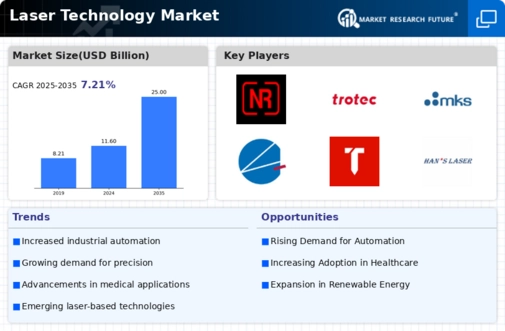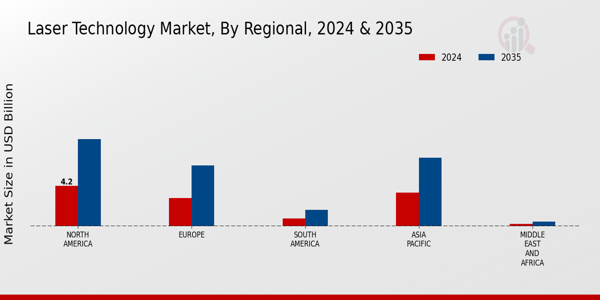Fiber Laser
Solid-State Laser
Gas Laser
Semiconductor Laser
Material Processing
Medical
Communication
Defense
Aerospace
Manufacturing
Healthcare
Telecommunications
Automotive
Defense
Continuous Wave Laser
Pulsed Laser
Ultrafast Laser
North America
Europe
South America
Asia Pacific
Middle East and Africa
North America Outlook (USD Billion, 2019-2035)
North America Laser Technology Market by Technology Type
Fiber Laser
Solid-State Laser
Gas Laser
Semiconductor Laser
North America Laser Technology Market by Application Type
Material Processing
Medical
Communication
Defense
Aerospace
North America Laser Technology Market by End Use Industry Type
Manufacturing
Healthcare
Telecommunications
Automotive
Defense
North America Laser Technology Market by Laser Type
Continuous Wave Laser
Pulsed Laser
Ultrafast Laser
North America Laser Technology Market by Regional Type
US
Canada
US Outlook (USD Billion, 2019-2035)
US Laser Technology Market by Technology Type
Fiber Laser
Solid-State Laser
Gas Laser
Semiconductor Laser
US Laser Technology Market by Application Type
Material Processing
Medical
Communication
Defense
Aerospace
US Laser Technology Market by End Use Industry Type
Manufacturing
Healthcare
Telecommunications
Automotive
Defense
US Laser Technology Market by Laser Type
Continuous Wave Laser
Pulsed Laser
Ultrafast Laser
CANADA Outlook (USD Billion, 2019-2035)
CANADA Laser Technology Market by Technology Type
Fiber Laser
Solid-State Laser
Gas Laser
Semiconductor Laser
CANADA Laser Technology Market by Application Type
Material Processing
Medical
Communication
Defense
Aerospace
CANADA Laser Technology Market by End Use Industry Type
Manufacturing
Healthcare
Telecommunications
Automotive
Defense
CANADA Laser Technology Market by Laser Type
Continuous Wave Laser
Pulsed Laser
Ultrafast Laser
Europe Outlook (USD Billion, 2019-2035)
Europe Laser Technology Market by Technology Type
Fiber Laser
Solid-State Laser
Gas Laser
Semiconductor Laser
Europe Laser Technology Market by Application Type
Material Processing
Medical
Communication
Defense
Aerospace
Europe Laser Technology Market by End Use Industry Type
Manufacturing
Healthcare
Telecommunications
Automotive
Defense
Europe Laser Technology Market by Laser Type
Continuous Wave Laser
Pulsed Laser
Ultrafast Laser
Europe Laser Technology Market by Regional Type
Germany
UK
France
Russia
Italy
Spain
Rest of Europe
GERMANY Outlook (USD Billion, 2019-2035)
GERMANY Laser Technology Market by Technology Type
Fiber Laser
Solid-State Laser
Gas Laser
Semiconductor Laser
GERMANY Laser Technology Market by Application Type
Material Processing
Medical
Communication
Defense
Aerospace
GERMANY Laser Technology Market by End Use Industry Type
Manufacturing
Healthcare
Telecommunications
Automotive
Defense
GERMANY Laser Technology Market by Laser Type
Continuous Wave Laser
Pulsed Laser
Ultrafast Laser
UK Outlook (USD Billion, 2019-2035)
UK Laser Technology Market by Technology Type
Fiber Laser
Solid-State Laser
Gas Laser
Semiconductor Laser
UK Laser Technology Market by Application Type
Material Processing
Medical
Communication
Defense
Aerospace
UK Laser Technology Market by End Use Industry Type
Manufacturing
Healthcare
Telecommunications
Automotive
Defense
UK Laser Technology Market by Laser Type
Continuous Wave Laser
Pulsed Laser
Ultrafast Laser
FRANCE Outlook (USD Billion, 2019-2035)
FRANCE Laser Technology Market by Technology Type
Fiber Laser
Solid-State Laser
Gas Laser
Semiconductor Laser
FRANCE Laser Technology Market by Application Type
Material Processing
Medical
Communication
Defense
Aerospace
FRANCE Laser Technology Market by End Use Industry Type
Manufacturing
Healthcare
Telecommunications
Automotive
Defense
FRANCE Laser Technology Market by Laser Type
Continuous Wave Laser
Pulsed Laser
Ultrafast Laser
RUSSIA Outlook (USD Billion, 2019-2035)
RUSSIA Laser Technology Market by Technology Type
Fiber Laser
Solid-State Laser
Gas Laser
Semiconductor Laser
RUSSIA Laser Technology Market by Application Type
Material Processing
Medical
Communication
Defense
Aerospace
RUSSIA Laser Technology Market by End Use Industry Type
Manufacturing
Healthcare
Telecommunications
Automotive
Defense
RUSSIA Laser Technology Market by Laser Type
Continuous Wave Laser
Pulsed Laser
Ultrafast Laser
ITALY Outlook (USD Billion, 2019-2035)
ITALY Laser Technology Market by Technology Type
Fiber Laser
Solid-State Laser
Gas Laser
Semiconductor Laser
ITALY Laser Technology Market by Application Type
Material Processing
Medical
Communication
Defense
Aerospace
ITALY Laser Technology Market by End Use Industry Type
Manufacturing
Healthcare
Telecommunications
Automotive
Defense
ITALY Laser Technology Market by Laser Type
Continuous Wave Laser
Pulsed Laser
Ultrafast Laser
SPAIN Outlook (USD Billion, 2019-2035)
SPAIN Laser Technology Market by Technology Type
Fiber Laser
Solid-State Laser
Gas Laser
Semiconductor Laser
SPAIN Laser Technology Market by Application Type
Material Processing
Medical
Communication
Defense
Aerospace
SPAIN Laser Technology Market by End Use Industry Type
Manufacturing
Healthcare
Telecommunications
Automotive
Defense
SPAIN Laser Technology Market by Laser Type
Continuous Wave Laser
Pulsed Laser
Ultrafast Laser
REST OF EUROPE Outlook (USD Billion, 2019-2035)
REST OF EUROPE Laser Technology Market by Technology Type
Fiber Laser
Solid-State Laser
Gas Laser
Semiconductor Laser
REST OF EUROPE Laser Technology Market by Application Type
Material Processing
Medical
Communication
Defense
Aerospace
REST OF EUROPE Laser Technology Market by End Use Industry Type
Manufacturing
Healthcare
Telecommunications
Automotive
Defense
REST OF EUROPE Laser Technology Market by Laser Type
Continuous Wave Laser
Pulsed Laser
Ultrafast Laser
APAC Outlook (USD Billion, 2019-2035)
APAC Laser Technology Market by Technology Type
Fiber Laser
Solid-State Laser
Gas Laser
Semiconductor Laser
APAC Laser Technology Market by Application Type
Material Processing
Medical
Communication
Defense
Aerospace
APAC Laser Technology Market by End Use Industry Type
Manufacturing
Healthcare
Telecommunications
Automotive
Defense
APAC Laser Technology Market by Laser Type
Continuous Wave Laser
Pulsed Laser
Ultrafast Laser
APAC Laser Technology Market by Regional Type
China
India
Japan
South Korea
Malaysia
Thailand
Indonesia
Rest of APAC
CHINA Outlook (USD Billion, 2019-2035)
CHINA Laser Technology Market by Technology Type
Fiber Laser
Solid-State Laser
Gas Laser
Semiconductor Laser
CHINA Laser Technology Market by Application Type
Material Processing
Medical
Communication
Defense
Aerospace
CHINA Laser Technology Market by End Use Industry Type
Manufacturing
Healthcare
Telecommunications
Automotive
Defense
CHINA Laser Technology Market by Laser Type
Continuous Wave Laser
Pulsed Laser
Ultrafast Laser
INDIA Outlook (USD Billion, 2019-2035)
INDIA Laser Technology Market by Technology Type
Fiber Laser
Solid-State Laser
Gas Laser
Semiconductor Laser
INDIA Laser Technology Market by Application Type
Material Processing
Medical
Communication
Defense
Aerospace
INDIA Laser Technology Market by End Use Industry Type
Manufacturing
Healthcare
Telecommunications
Automotive
Defense
INDIA Laser Technology Market by Laser Type
Continuous Wave Laser
Pulsed Laser
Ultrafast Laser
JAPAN Outlook (USD Billion, 2019-2035)
JAPAN Laser Technology Market by Technology Type
Fiber Laser
Solid-State Laser
Gas Laser
Semiconductor Laser
JAPAN Laser Technology Market by Application Type
Material Processing
Medical
Communication
Defense
Aerospace
JAPAN Laser Technology Market by End Use Industry Type
Manufacturing
Healthcare
Telecommunications
Automotive
Defense
JAPAN Laser Technology Market by Laser Type
Continuous Wave Laser
Pulsed Laser
Ultrafast Laser
SOUTH KOREA Outlook (USD Billion, 2019-2035)
SOUTH KOREA Laser Technology Market by Technology Type
Fiber Laser
Solid-State Laser
Gas Laser
Semiconductor Laser
SOUTH KOREA Laser Technology Market by Application Type
Material Processing
Medical
Communication
Defense
Aerospace
SOUTH KOREA Laser Technology Market by End Use Industry Type
Manufacturing
Healthcare
Telecommunications
Automotive
Defense
SOUTH KOREA Laser Technology Market by Laser Type
Continuous Wave Laser
Pulsed Laser
Ultrafast Laser
MALAYSIA Outlook (USD Billion, 2019-2035)
MALAYSIA Laser Technology Market by Technology Type
Fiber Laser
Solid-State Laser
Gas Laser
Semiconductor Laser
MALAYSIA Laser Technology Market by Application Type
Material Processing
Medical
Communication
Defense
Aerospace
MALAYSIA Laser Technology Market by End Use Industry Type
Manufacturing
Healthcare
Telecommunications
Automotive
Defense
MALAYSIA Laser Technology Market by Laser Type
Continuous Wave Laser
Pulsed Laser
Ultrafast Laser
THAILAND Outlook (USD Billion, 2019-2035)
THAILAND Laser Technology Market by Technology Type
Fiber Laser
Solid-State Laser
Gas Laser
Semiconductor Laser
THAILAND Laser Technology Market by Application Type
Material Processing
Medical
Communication
Defense
Aerospace
THAILAND Laser Technology Market by End Use Industry Type
Manufacturing
Healthcare
Telecommunications
Automotive
Defense
THAILAND Laser Technology Market by Laser Type
Continuous Wave Laser
Pulsed Laser
Ultrafast Laser
INDONESIA Outlook (USD Billion, 2019-2035)
INDONESIA Laser Technology Market by Technology Type
Fiber Laser
Solid-State Laser
Gas Laser
Semiconductor Laser
INDONESIA Laser Technology Market by Application Type
Material Processing
Medical
Communication
Defense
Aerospace
INDONESIA Laser Technology Market by End Use Industry Type
Manufacturing
Healthcare
Telecommunications
Automotive
Defense
INDONESIA Laser Technology Market by Laser Type
Continuous Wave Laser
Pulsed Laser
Ultrafast Laser
REST OF APAC Outlook (USD Billion, 2019-2035)
REST OF APAC Laser Technology Market by Technology Type
Fiber Laser
Solid-State Laser
Gas Laser
Semiconductor Laser
REST OF APAC Laser Technology Market by Application Type
Material Processing
Medical
Communication
Defense
Aerospace
REST OF APAC Laser Technology Market by End Use Industry Type
Manufacturing
Healthcare
Telecommunications
Automotive
Defense
REST OF APAC Laser Technology Market by Laser Type
Continuous Wave Laser
Pulsed Laser
Ultrafast Laser
South America Outlook (USD Billion, 2019-2035)
South America Laser Technology Market by Technology Type
Fiber Laser
Solid-State Laser
Gas Laser
Semiconductor Laser
South America Laser Technology Market by Application Type
Material Processing
Medical
Communication
Defense
Aerospace
South America Laser Technology Market by End Use Industry Type
Manufacturing
Healthcare
Telecommunications
Automotive
Defense
South America Laser Technology Market by Laser Type
Continuous Wave Laser
Pulsed Laser
Ultrafast Laser
South America Laser Technology Market by Regional Type
Brazil
Mexico
Argentina
Rest of South America
BRAZIL Outlook (USD Billion, 2019-2035)
BRAZIL Laser Technology Market by Technology Type
Fiber Laser
Solid-State Laser
Gas Laser
Semiconductor Laser
BRAZIL Laser Technology Market by Application Type
Material Processing
Medical
Communication
Defense
Aerospace
BRAZIL Laser Technology Market by End Use Industry Type
Manufacturing
Healthcare
Telecommunications
Automotive
Defense
BRAZIL Laser Technology Market by Laser Type
Continuous Wave Laser
Pulsed Laser
Ultrafast Laser
MEXICO Outlook (USD Billion, 2019-2035)
MEXICO Laser Technology Market by Technology Type
Fiber Laser
Solid-State Laser
Gas Laser
Semiconductor Laser
MEXICO Laser Technology Market by Application Type
Material Processing
Medical
Communication
Defense
Aerospace
MEXICO Laser Technology Market by End Use Industry Type
Manufacturing
Healthcare
Telecommunications
Automotive
Defense
MEXICO Laser Technology Market by Laser Type
Continuous Wave Laser
Pulsed Laser
Ultrafast Laser
ARGENTINA Outlook (USD Billion, 2019-2035)
ARGENTINA Laser Technology Market by Technology Type
Fiber Laser
Solid-State Laser
Gas Laser
Semiconductor Laser
ARGENTINA Laser Technology Market by Application Type
Material Processing
Medical
Communication
Defense
Aerospace
ARGENTINA Laser Technology Market by End Use Industry Type
Manufacturing
Healthcare
Telecommunications
Automotive
Defense
ARGENTINA Laser Technology Market by Laser Type
Continuous Wave Laser
Pulsed Laser
Ultrafast Laser
REST OF SOUTH AMERICA Outlook (USD Billion, 2019-2035)
REST OF SOUTH AMERICA Laser Technology Market by Technology Type
Fiber Laser
Solid-State Laser
Gas Laser
Semiconductor Laser
REST OF SOUTH AMERICA Laser Technology Market by Application Type
Material Processing
Medical
Communication
Defense
Aerospace
REST OF SOUTH AMERICA Laser Technology Market by End Use Industry Type
Manufacturing
Healthcare
Telecommunications
Automotive
Defense
REST OF SOUTH AMERICA Laser Technology Market by Laser Type
Continuous Wave Laser
Pulsed Laser
Ultrafast Laser
MEA Outlook (USD Billion, 2019-2035)
MEA Laser Technology Market by Technology Type
Fiber Laser
Solid-State Laser
Gas Laser
Semiconductor Laser
MEA Laser Technology Market by Application Type
Material Processing
Medical
Communication
Defense
Aerospace
MEA Laser Technology Market by End Use Industry Type
Manufacturing
Healthcare
Telecommunications
Automotive
Defense
MEA Laser Technology Market by Laser Type
Continuous Wave Laser
Pulsed Laser
Ultrafast Laser
MEA Laser Technology Market by Regional Type
GCC Countries
South Africa
Rest of MEA
GCC COUNTRIES Outlook (USD Billion, 2019-2035)
GCC COUNTRIES Laser Technology Market by Technology Type
Fiber Laser
Solid-State Laser
Gas Laser
Semiconductor Laser
GCC COUNTRIES Laser Technology Market by Application Type
Material Processing
Medical
Communication
Defense
Aerospace
GCC COUNTRIES Laser Technology Market by End Use Industry Type
Manufacturing
Healthcare
Telecommunications
Automotive
Defense
GCC COUNTRIES Laser Technology Market by Laser Type
Continuous Wave Laser
Pulsed Laser
Ultrafast Laser
SOUTH AFRICA Outlook (USD Billion, 2019-2035)
SOUTH AFRICA Laser Technology Market by Technology Type
Fiber Laser
Solid-State Laser
Gas Laser
Semiconductor Laser
SOUTH AFRICA Laser Technology Market by Application Type
Material Processing
Medical
Communication
Defense
Aerospace
SOUTH AFRICA Laser Technology Market by End Use Industry Type
Manufacturing
Healthcare
Telecommunications
Automotive
Defense
SOUTH AFRICA Laser Technology Market by Laser Type
Continuous Wave Laser
Pulsed Laser
Ultrafast Laser
REST OF MEA Outlook (USD Billion, 2019-2035)
REST OF MEA Laser Technology Market by Technology Type
Fiber Laser
Solid-State Laser
Gas Laser
Semiconductor Laser
REST OF MEA Laser Technology Market by Application Type
Material Processing
Medical
Communication
Defense
Aerospace
REST OF MEA Laser Technology Market by End Use Industry Type
Manufacturing
Healthcare
Telecommunications
Automotive
Defense
REST OF MEA Laser Technology Market by Laser Type
Continuous Wave Laser
Pulsed Laser
Ultrafast Laser















Leave a Comment